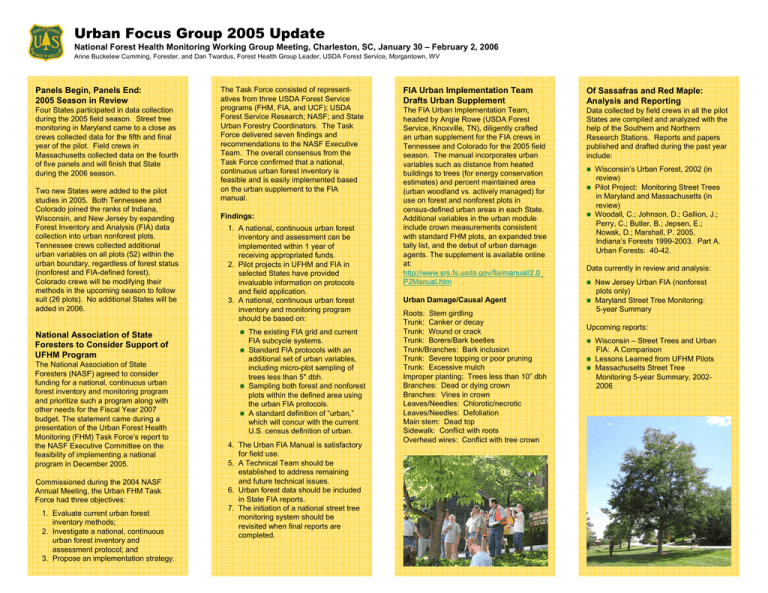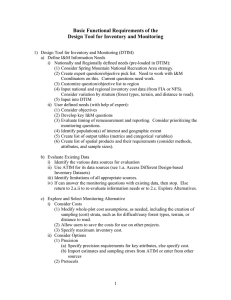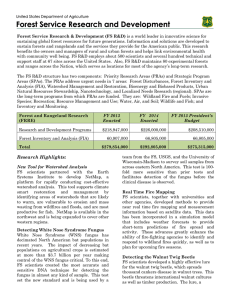Urban Focus Group 2005 Update
advertisement

Urban Focus Group 2005 Update National Forest Health Monitoring Working Group Meeting, Charleston, SC, January 30 – February 2, 2006 Anne Buckelew Cumming, Forester, and Dan Twardus, Forest Health Group Leader, USDA Forest Service, Morgantown, WV Panels Begin, Panels End: 2005 Season in Review Four States participated in data collection during the 2005 field season. Street tree monitoring in Maryland came to a close as crews collected data for the fifth and final year of the pilot. Field crews in Massachusetts collected data on the fourth of five panels and will finish that State during the 2006 season. Two new States were added to the pilot studies in 2005. Both Tennessee and Colorado joined the ranks of Indiana, Wisconsin, and New Jersey by expanding Forest Inventory and Analysis (FIA) data collection into urban nonforest plots. Tennessee crews collected additional urban variables on all plots (52) within the urban boundary, regardless of forest status (nonforest and FIA-defined forest). Colorado crews will be modifying their methods in the upcoming season to follow suit (26 plots). No additional States will be added in 2006. National Association of State Foresters to Consider Support of UFHM Program The National Association of State Foresters (NASF) agreed to consider funding for a national, continuous urban forest inventory and monitoring program and prioritize such a program along with other needs for the Fiscal Year 2007 budget. The statement came during a presentation of the Urban Forest Health Monitoring (FHM) Task Force’s report to the NASF Executive Committee on the feasibility of implementing a national program in December 2005. Commissioned during the 2004 NASF Annual Meeting, the Urban FHM Task Force had three objectives: 1. Evaluate current urban forest inventory methods; 2. Investigate a national, continuous urban forest inventory and assessment protocol; and 3. Propose an implementation strategy. The Task Force consisted of representatives from three USDA Forest Service programs (FHM, FIA, and UCF); USDA Forest Service Research; NASF; and State Urban Forestry Coordinators. The Task Force delivered seven findings and recommendations to the NASF Executive Team. The overall consensus from the Task Force confirmed that a national, continuous urban forest inventory is feasible and is easily implemented based on the urban supplement to the FIA manual. Findings: 1. A national, continuous urban forest inventory and assessment can be implemented within 1 year of receiving appropriated funds. 2. Pilot projects in UFHM and FIA in selected States have provided invaluable information on protocols and field application. 3. A national, continuous urban forest inventory and monitoring program should be based on: The existing FIA grid and current FIA subcycle systems. Standard FIA protocols with an additional set of urban variables, including micro-plot sampling of trees less than 5″ dbh. Sampling both forest and nonforest plots within the defined area using the urban FIA protocols. A standard definition of “urban,” which will concur with the current U.S. census definition of urban. 4. The Urban FIA Manual is satisfactory for field use. 5. A Technical Team should be established to address remaining and future technical issues. 6. Urban forest data should be included in State FIA reports. 7. The initiation of a national street tree monitoring system should be revisited when final reports are completed. FIA Urban Implementation Team Drafts Urban Supplement Of Sassafras and Red Maple: Analysis and Reporting The FIA Urban Implementation Team, headed by Angie Rowe (USDA Forest Service, Knoxville, TN), diligently crafted an urban supplement for the FIA crews in Tennessee and Colorado for the 2005 field season. The manual incorporates urban variables such as distance from heated buildings to trees (for energy conservation estimates) and percent maintained area (urban woodland vs. actively managed) for use on forest and nonforest plots in census-defined urban areas in each State. Additional variables in the urban module include crown measurements consistent with standard FHM plots, an expanded tree tally list, and the debut of urban damage agents. The supplement is available online at: http://www.srs.fs.usda.gov/fia/manual/2.0_ P2Manual.htm Data collected by field crews in all the pilot States are compiled and analyzed with the help of the Southern and Northern Research Stations. Reports and papers published and drafted during the past year include: Urban Damage/Causal Agent Roots: Stem girdling Trunk: Canker or decay Trunk: Wound or crack Trunk: Borers/Bark beetles Trunk/Branches: Bark inclusion Trunk: Severe topping or poor pruning Trunk: Excessive mulch Improper planting: Trees less than 10” dbh Branches: Dead or dying crown Branches: Vines in crown Leaves/Needles: Chlorotic/necrotic Leaves/Needles: Defoliation Main stem: Dead top Sidewalk: Conflict with roots Overhead wires: Conflict with tree crown Wisconsin’s Urban Forest, 2002 (in review) Pilot Project: Monitoring Street Trees in Maryland and Massachusetts (in review) Woodall, C.; Johnson, D.; Gallion, J.; Perry, C.; Butler, B.; Jepsen, E.; Nowak, D.; Marshall, P. 2005. Indiana’s Forests 1999-2003. Part A. Urban Forests: 40-42. Data currently in review and analysis: New Jersey Urban FIA (nonforest plots only) Maryland Street Tree Monitoring: 5-year Summary Upcoming reports: Wisconsin – Street Trees and Urban FIA: A Comparison Lessons Learned from UFHM Pilots Massachusetts Street Tree Monitoring 5-year Summary, 20022006


